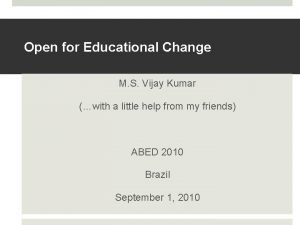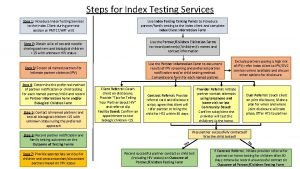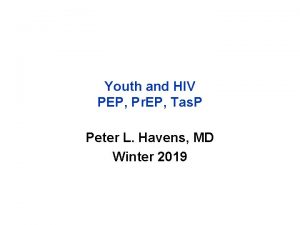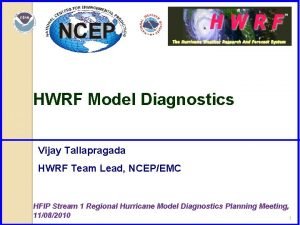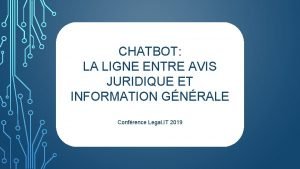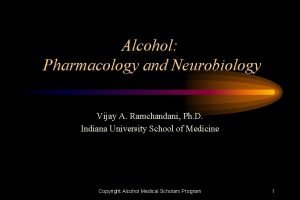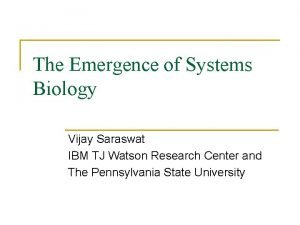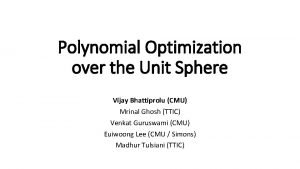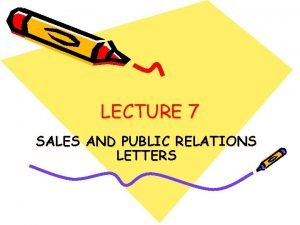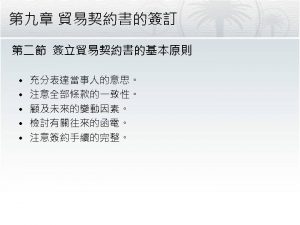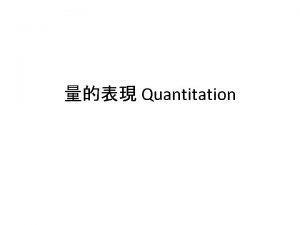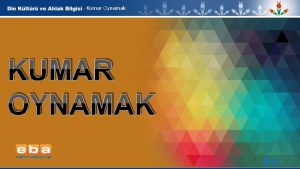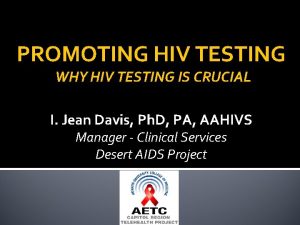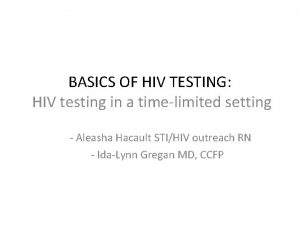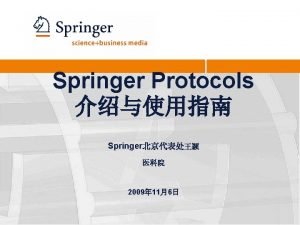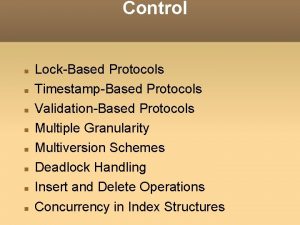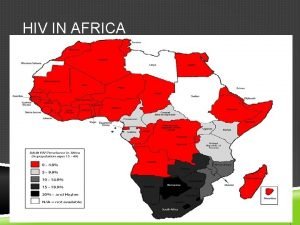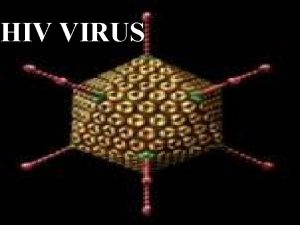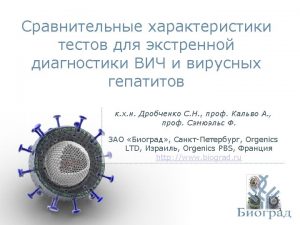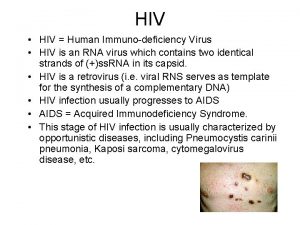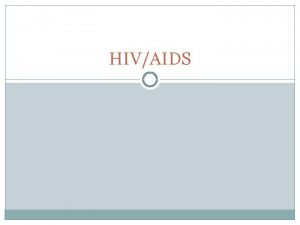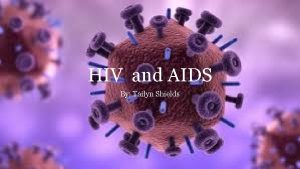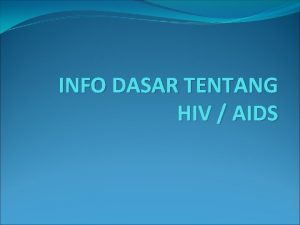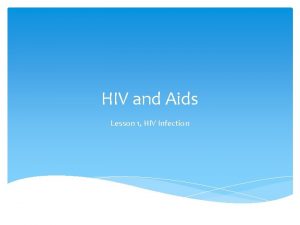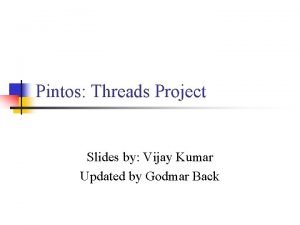HIV TESTING PROTOCOLS D Vijay kumar Dist Sales





































- Slides: 37

HIV TESTING PROTOCOLS D. Vijay kumar Dist. Sales Manager Abbott Hyderabad.

Informed consent prior to testing is essential to deal with issues like- §Confidentiality §Discrimination §Victimization §Psychological harm * HIV testing – voluntary Mandatory testing – counterproductive

Purpose of HIV testing

§ Transfusion safety § Epidemiological - Sentinel surveillance § Diagnostic purpose § Voluntary testing § Research

PPTCT Pregnant HIV infected women can§ make informed decisions about dealing with pregnancy § receive appropriate and timely interventions to decrease MTCT § ensure safe delivery § secure early access to HIV care and treatment § educated in prevention of HIV transmission § receive follow-up health care for self and child Pregnant HIV non infected women can be educated and counselled to remain uninfected

Serological Profile of HIV infection

Tests for detecting HIV INFECTION § Detection of specific antibodies screening tests: 100% sensitive supplemental/ confirmatory testssens. > 99. 8% spec. > 98. 5% § Detection of specific antigens

SELECTION OF TESTS : BASED ON SENSITIVITY , SPECIFICITY, EFFICIENCY, PPV & NPV Sensitivity – Accuracy with which a test can confirm the presence of an infection. Test with high sensitivity – few false negatives TP Sensitivity = x 100 TP + FN

SPECIFICITYAccuracy with which the test can confirm the absence of an infection test with high specificity – few false positives used for diagnosing infection in an individual TN Specificity = X 100 TN + FP

Efficiency - ability of a test to correctly identify all positives as positives all negatives as negatives TP + TN Efficiency = X 100 TP + FN + TN + FP

Predictive values PPV – identifies ACTUALLY infected individuals TP X 100 TP + FP NPV – identifies ACTUAL non infected TN X 100 TN + FN

ELISA § Most common screening test § Indirect solid phase enzyme linked immunosorbent assay/ EIA § Used in blood banks/ tertiary labs § Fourth generation ELISA decreases window period § § DISADVANTAGES Many false positives Few false negatives Time consuming Needs infrastructure & tech. expertise

PRINCIPLE OF INDIRECT ELISA Substrate Enzyme conjugated Anti-HIV antibody in specime Antigen On solid phase

ELISA cont. § False positives: auto immune diseases multiple pregnancies hematologic malignancies primary biliary cirrhosis alcoholic hepatitis CRF § False negatives window period immunosuppressive therapy malignant disorders late stage disease technical errors

Rapid tests § Dot blot assay- immuno concentration method Retroquic -line assay Tridot - dot assay § Immunocomb assay – dipstick/comb ELISA based HIV comb coomb AIDS § Immunochromatography – lateral flow assays Determine, Unigold, Hemastrip § Particle aggluttination – Capillus, Serodia § ELISA based - EIA

Comb AIDS ØDot immunoassay for HIV 1&2 using whole blood, serum or plasma. Comb with 8 teeth- Megenta red spot ØSynthetic& recombinant peptides used ØTwo spots-- Control spot & test spot. NON-REACTIVE For HIV-1 &2 INVALID TEST

TRIDOT § HIV 1 – gp 41, gp 120. § HIV 2 – gp 36. § Highly specific. C 1 2

RETROQUIC HIV

HIV EIA Comb

HIV EIA Comb ØRapid Visual EIA Test ØDetection of Antibodies to HIV-1 (including subgroups O & C) and HIV-2 Ø Sensitivity (100%) Ø Specificity (99. 9%) INTERPRETATION OF RESULTS NON-REACTIVE HIV-1 HIV-2 HIV-1&2 INVALID TEST

SUPPLEMENTAL TESTS § § 1. Rapid tests. 2. Western blot. 3. Immunoblot. 4. Line immunoassay. § WB/IB/LIA: highly specific but Expensive Labour intensive Needs expertise Equivocal/indeterminate results.

Western Blot for HIV § Delineates the antibody profile of reactive serum WB Rotator platform § Used to grade intensity of ab response – Qualitatively – Quantitatively § Procedure based on principle of ELISA WB strips

Western blot for HIV antibody gp Control band 36 p 24 gp 31 gp 41 gp 120 & 160

TESTS DONE IN VCCTC, PPTCT & BLOOD BANK VCCTC & PPTCT: Test – I: HIV Comb / Comb Aids – RS Test – II: Tridot / Retroquic Test – III: EIA Comb FOR SURVEILLANCE: Test – I: HIV Comb / Comb Aids – RS Test – II: Tridot / Retroquic BLOOD BANK: Only Test: Microlisa HIV

STRATEGIES/ALGORITHMS OF HIV TESTING 1. Screening ELISA/Rapid tests – used in strategy I, III. 2. Supplemental tests – E/R & Western Blot. Strategy I (for transfusion/transplantation safety) one test kit required AI A 1 + A 1 positive negative

Strategy/Algorithm II A (for surveillance) 2 test kits required A 1 + A 1 Report negative A 2 A 1 + A 2 + A 1+ A 2 Report positive Report negative

Strategy/Algorithm II B (Diagnosis of an individual with AIDS indicator disease symptoms) 3 test kits required A 1 + A 1 report negative A 2 A 1+ A 2 + report positive A 1+ A 2 - A 3 A 1+ A 2 – A 3+ A 1+ A 2 - A 3 indeterminate report negative

Strategy/Algorithm III To detect HIV infection in asymptomatic individuals (VCTCs, PPTCTs) 3 test kits required A 1+ A 1 Report negative A 2 A 1+ A 2 + A 1+ A 2 – A 3 A 1+ A 2+ A 3+ Report positive A 1+ A 2+ A 3 indeterminate A 3 A 1+ A 2 - A 3+ A 1+ A 2 - A 3 Indeterminate report negative

§ INDETERMINATE STATUS: Repeat test after 14 -28 days. Results continue to be indeterminate – WB/PCR refer to NRL. § EQUIVOCAL WB: Rpt. WB after 2 weeks 4 weeks 12 weeks one year. Correlate with high risk behaviour & clinical parameters.

TESTS TO DETECT ANTIGENS § P 24 Antigen: Uncomplexed in serum, plasma, CSF, cell culture. Indicates Active infection especially in newborn. Resolves equivocal WB. Window period. CNS disease. Immune collapse. Monitoring response to ART. Method: EIA Disadvantages: Expensive. Limited sensitivity. Failure to detect HIV 2. Failure to detect Ag when complexed with Antibody

Limitations of antigen detection methods § § § Not reliable Expensive Limited sensitivity-69% in patients with AIDS, 15% in neonates Detection not possible in patients with high anti p 24 antibody Cannot be used as a screening test

PCR § Highly specific test-more than 95% § Highly sensitive-infants over 1 month § Detects proviral DNA. § Detects both latent viral infection and active viral transcriptipn. § Detects viral load. § Detects both HIV 1 & HIV 2.

PCR AS VIRAL ASSAYS IN INFANTS § Counselling for infant feeding & therapeutic intervention. § First done at 6 weeks. § Not Breast-fed, to say not infected: 2 negative test after 1 month (include 1 at 4 months) § Not done as part of PPTCT in India. § If symptoms occur at < 18 months: go for viral assays.

Diagnosing HIV infection in an infant born to HIV positive mother Protocol 1 Asymptomatic 18 months-ELISA Non-reactive Conditionally consider Non-infected Re-test NR HIV Unifected Reactive confirm with a retest

PROTOCOL 2 SYMPTOMATIC Early symptoms Earlier than 12 mon. Viral assay at 6 weeks Whenever symptoms occur Retest 1 month later If both are reactive consider reactive AIDS defined symptoms same as for early symptoms ELISA at 12 months Non reactive Follow protocol 1 Retest at 18 months Non reactive HIV UNIFECTED Reactive conditionally consider HIV + ve retest at 18 months reactive HIV INFECTED

HIV TESTING POLICY IN PPTCT § PARENT: Informed consent of the patient Pre n post test counselling Routine testing with three rapid tests first: highly sensitive test-NR-reported with exception of WP Indeterminate: 1 st test reactive, 2 nd/3 rd NR repeat test after 14 -28 days. WB/PCR: For persistent indeterminate cases. § INFANT OF HIV + MOTHER, ASYMPTOMATIC: ELISA at 18 months—NR—Retest—NR—uninfected. Reactive—consider infected, confirm with retest. § INFANT OF HIV + MOTHER, SYMPTOMATIC: ELISA at 12 months—NR—retest NR—uninfected. Reactive—retest R at 18 months—infected.

 Iihs moodle
Iihs moodle Pavan kumar vijay
Pavan kumar vijay Dr. vijay kumar
Dr. vijay kumar Pavan kumar vijay
Pavan kumar vijay Distensio musculi
Distensio musculi Areas table
Areas table Approche index testing
Approche index testing Cdc hiv testing
Cdc hiv testing Vijay kharadi ias
Vijay kharadi ias Vijay nayar
Vijay nayar R. vijay krishna
R. vijay krishna Vijay tallapragada
Vijay tallapragada Vijay
Vijay Vijay jeshang
Vijay jeshang Vijay ramchandani
Vijay ramchandani Vijay samant
Vijay samant Vijay sathaye
Vijay sathaye Vijay kharadi ias
Vijay kharadi ias Vijay saraswat
Vijay saraswat Vijay bhattiprolu
Vijay bhattiprolu Vijay tewari
Vijay tewari Dr vijay aswani death
Dr vijay aswani death Difference between sales letter and sales promotion letter
Difference between sales letter and sales promotion letter Sales potential vs sales forecast
Sales potential vs sales forecast Salesforce sales organization structure
Salesforce sales organization structure Sales force structure example
Sales force structure example Sales quotas and territories
Sales quotas and territories Software domain examples
Software domain examples Decision table testing in software testing
Decision table testing in software testing Positive testing and negative testing
Positive testing and negative testing Domain testing example
Domain testing example Rigorous testing in software testing
Rigorous testing in software testing Cause effect graph for triangle problem
Cause effect graph for triangle problem Metode black box
Metode black box Logic based testing in software testing
Logic based testing in software testing Cs3250
Cs3250 Testing blindness in software testing
Testing blindness in software testing Control structure testing in software engineering
Control structure testing in software engineering
